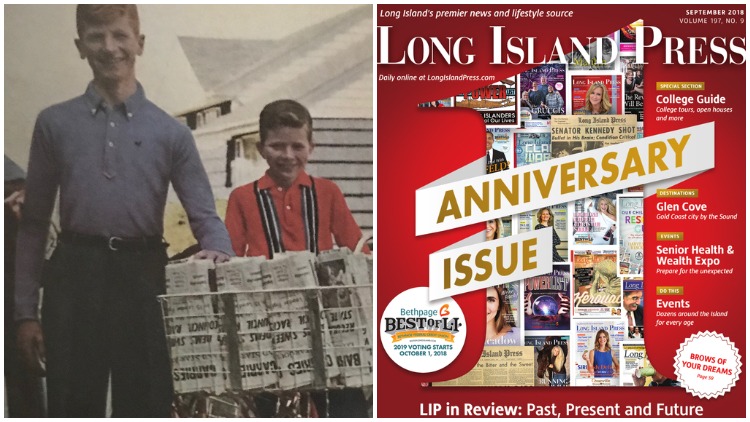A year ago this month, the Long Island Press relaunched as a monthly news and lifestyle publication, keeping alive a proud tradition dating back 197 years — and what a year it’s been.
But informing readers of the region’s recent shake-ups or sharing entertaining interviews with hometown heroes such as Jerry Seinfeld or Christie Brinkley are just a blip on the radar compared to the nearly two centuries of LI history chronicled in the pages our predecessors published. The earliest incarnation of the newspaper, then called the Long Island Farmer, preexisted the Long Island Rail Road, the formation of which it covered.
“The great and paramount advantages resulting from railroads … in furnishing the cheapest, the safest and most expeditious mode of conveyance … are now universally known and appreciated,” the Farmer wrote in 1834, two years before the LIRR was chartered.
THE PAST
A lot has changed since then, and not just the perceived affordability and expeditiousness of riding the LIRR. When the Farmer was founded in 1821, James Monroe, the nation’s fifth president, was beginning his second term in the White House. The U.S. had just bought Florida from Spain. Missouri became the 24th state.
“Fear no man and do justice to all men,” was the paper’s motto during the Civil War.
The Farmer was also around to report on the opening of the Brooklyn Bridge, LI’s first crossing into Manhattan, in 1883. Back then, there was no debate over whether Queens was really part of Long Island, since everyone from Brooklyn to Montauk needed a boat to get to the mainland. For the first 156 years of its existence, the Farmer and the Press were based out of Queens, predating the formation of Nassau County in 1899.
Since its founding, the population of LI has grown from 56,978 — slightly more than the Village of Hempstead today — to 7.5 million, or 2.8 million for those that only consider the Island to be Nassau and Suffolk. As the population grew with expansions of the LIRR, construction of additional East River crossings and, after World War II, the development of America’s first suburb, in Levittown, the Press’ coverage followed its readers east.
Among the daily Press reporters still in the media is Karl Grossman, the dean of LI print journalism, who won the coveted George Polk Award for his Press reporting on sandmine excavation, and went on to found the Press Club of Long Island, the local chapter of the Society of Professional Journalists.
“The Levon Corporation was excavating a square mile of the bluff-fronted north shore at Jamesport on the North Fork under the guise of building a deep-water port,” recalled Grossman, who is pressing on after a half century in the business. “In fact, it was a huge sand mine, a massive rape of Long Island. The sand was being barged off to Connecticut to make concrete for interstate highways being built there. The scheme was stopped. The land is now a state park.”
At its peak, the Press had a circulation of more than 445,000 in 1969. Many a Baby Boomer shares fond memories of delivering the thick broadsheet newspaper as their first job. Among them are TV news personality Geraldo Rivera, who delivered the Press as a 12-year-old Babylon resident and credits one of the paper’s carrier contests with opening up the wide world he would later cover.
“Aside from the fact that it taught me business, costs and profits, the thing that I really loved was, you got tickets to Yankee Stadium and the Steeplechase at Coney Island,” Rivera said. “So the Long Island Press really was an eye-opening experience for me. It’s still a big part of my nostalgic recollections of life on Long Island.”
But the good times didn’t last. By 1977, increased production costs, decreased advertising revenue and a healthy competition led the then-publisher, Samuel I. Newhouse, to pull the plug on the Press after 156 years in business. It was the end of an era.
THE PRESENT
Twenty-six years later, Jed Morey, whose family owned WLIR, the famed alternative rock radio station, revived the dormant title as an alternative newsweekly. Rumors flew that the Press would again go daily, although it only did so online.
A decade later, the Press reduced its publication to monthly, and a year after that, in 2014, it went digital. That is, until Victoria Schneps-Yunis and her son, Joshua Schneps, who co-own a chain of newspapers in the New York Metro area, reinvented the Press and brought it back to print last year.
Samuel Newhouse died a month after his old paper rolled off the presses. And three months after that, John Kominicki, the local journalism legend who was hired as publisher to lead the relaunch, joined Newhouse at the big newsroom in the sky.
THE FUTURE
Since then, the Press has soldiered on, informing and entertaining readers, keeping the tradition alive, and breaking news along the way. What does the future look like for the Press and its readers? Guess you’ll just have to keep reading to find out.
LI PRESS AT A GLANCE
January 4, 1821: The Long Island Farmer, a weekly publication based in Jamaica, Queens, was founded by Henry C. Sleight, a Sag Harbor native who served in the War of 1812.
1831: Sleight passed the paper to Thomas Bradlee, a justice of the peace and police justice in Jamaica, who turned the paper over to Isaac F. Jones a year later.
1840: Jones transferred the publication to Charles S. Watrous. March
1849: B.H. Willis takes over from Watrous.
1860: Charles Welling becomes publisher.
1891: John C. Kennehan of Great Neck Hills buys the Farmer and makes it a daily newspaper.
1919: Kennehan’s nephew, James F. Sullivan, takes over after the publisher dies, and soon sells his interest to James F. O’Rourke.
1920: Benjamin Marvin buys the paper and changes the name to the Long Island Daily Press and Farmer.
1926: German newspaper publishers the Ridder Brothers purchase the paper, make William F. Hoffman publisher and shorten the name to the Long Island Press.
1932: The Ridders sell the Press to Samuel I. Newhouse, the founder of Advance Publications, which went on to absorb various media outlets, most notably the Condé Nast Publications magazine group.
March 25, 1977: Newhouse shuts down the Press amid declining ad revenue, increasing costs and boosted competition.
January, 2003: Jed Morey of WLIR alternative radio fame revives the title, which Newhouse had abandoned 26 years prior, and turns it into a free alternative newsweekly.
2013: The Press goes monthly and a year later, online only.
April 2017: Victoria Schneps-Yunis and her son, Joshua Schneps, acquire the Press from Morey and reinvent it as a monthly news and lifestyle publication in September of that year.



























